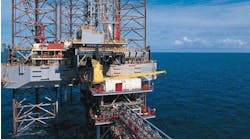John Waggoner
Drilling & Production Editor
A new generation of formation testing sensor technology from Halliburton makes it possible to recover reservoir fluid samples with logging-while-drilling (LWD) technology. The InSite GeoTap IDS combines both the real-time workability of the existing GeoTap formation pressure tester platform and fluid identification and sampling capabilities that were the domain of wireline testing.
The result is a package of LWD formation evaluation tools that is intended to save operators time and money, says Halliburton Sperry Drilling’s global product champion, Jim Wilson. "It’s literally time in a bottle," Wilson says of the time saved by fluid sampling-while-drilling.
By recovering well data more quickly, operators can act while drilling to optimize completion strategies. The new sensor does away with multiple sampling runs and can acquire reservoir data in hours rather than days. Fifteen or more fluid samples can be taken on a given run, adding additional security for understanding the reservoir fluids and hydrocarbon composition, including GOR, presence of asphaltenes, hydrates, paraffin, and other fluid characteristics.
"This kind of advance information can be used to help define the reservoir according to fluid recovered, which in turn can be used to make more accurate reserves estimates," Wilson says.
From the outside, the GeoTap IDS resembles the earlier generation GeoTap. Inside however, design and state-of-the-art machining make it possible to fit an array of electronic components within the 6 ¾-in. diameter tool. Building on its experience in downhole tool design, Halliburton integrates many of the sensor technologies developed for its wireline sampling tools into the GeoTap IDS sensor by repackaging them for the harsh drilling environment that LWD tools must endure.
"Run in the drilling BHA (bottomhole assembly), the sensor has the advantage of near-real-time sampling which greatly reduces formation cleanup time because less formation damage has occurred from invasion due to the short exposure time to the drilling fluids," Wilson says.
GeoTap family expands
The new sensor operates similarly to the GeoTap formation pressure tester, which provides the same subsurface pressure measurements using downhole hydraulics and a single pad/probe design, say its designers.
Similarly, using a closed hydraulic system, battery power, and quartz and strain gauges, on command the GeoTap IDS sensor extends a probe to establish a seal at the borehole wall in the target formation. It then performs multiple drawdown tests to measure formation pressure and to calculate formation fluid mobility.
Shown here is a rendition of the new GeoTap IDS tool, courtesy of Halliburton Sperry Drilling.
The sensor can be positioned anywhere in the LWD BHA, but typically is located directly above the formation evaluation sensor most critical to identifying the potential reservoir that requires added evaluation. If a sample is desired, the operator sends the command to commence the pump out while the oval pad is positioned on the formation.
As the flushing pump begins pulling the mud filtrate from the formation, a bubble point measurement of these initial fluids is taken to benchmark the invasion fluids. Afterwards, the flushing pump pulls the fluids past identification sensors to measure fluid temperature, pressure, resistivity, capacitance, and/or density.
"These measurements are monitored continuously as indicators of changes in fluid contamination," Wilson says. "Over time, the fluids being pumped through the GeoTap IDS sensor become less contaminated with mud filtrates and sensor responses stabilize, indicating that cleanup has been achieved."
Fluid then is diverted through a zero shock chamber to a series of 1-liter bottles, similar to those used in the wireline Reservoir Description Tool (RDT) tester. Positioned approximately 10 ft (3 m) from the LWD formation evaluation sensor, each GeoTap IDS sample collar contains up to five (RDT) bottles, and can be stacked to carry 15 fluid samples or more, if desired.
"Once you are satisfied with the quality and number of samples collected, the pump is stopped, the probe is retracted, and the drilling operation is free to continue, leaving you with the option of later acquiring additional samples in other zones," Wilson says.
Deepwater advantages
The cost of deepwater exploration is one of the key motivators for Halliburton Sperry Drilling’s innovation. With some deepwater rig rates ranging over $500,000/day, every hour saved can impact project economics.
One way the tool economizes time is to eliminate trips for wireline sampling tools, the company says. Another way is that taking samples while drilling can limit contamination of the formation by drilling fluids, so extended pump-out times to obtain clean samples can be reduced compared with wireline sampling.
With the GeoTap IDS sensor, the formation pressure measurements, fluid identification determinations, and sample collection may take as little as a few minutes or as much as several hours, depending on the formation characteristics and the job requirements.
"Since this is ‘testing-while-drilling,’ the data is obtained in real time and the samples are available immediately after the BHA has returned to surface. This saves you the time and expense of running a wireline sampling tool," Wilson says.
At some deepwater locations it is a standard procedure to drill an initial low directional pilot well in order to run gravity conveyed logging tools for reservoir analysis, and then cement and abandon it before drilling the horizontal well. Pilot wells are needed to confirm the top and base of reservoir targets, as well as to ensure precise seismic depth correlation. They also allow formation pressure testing, triple combo logging, and fluid sampling for characterization, flow evaluation, and other analyses.
The use of the GeoTap IDS sensor in combination with the LWD formation evaluation sensors eliminates the requirement for low angle pilot wells. "Instead of the standard procedure of cementing and abandoning the entire pilot well, we could use a significant length of it as part of the new horizontal well," Wilson says.




